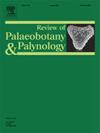来自沙特阿拉伯Hirnantian的淡水孢粉组合
IF 1.7
3区 地球科学
Q2 PALEONTOLOGY
引用次数: 0
摘要
一组来自沙特阿拉伯Hirnantian的样品,都含有淡水绿藻化石Moyeria Thusu,检测了它们的有机壁微化石(OWM)含量。虽然这些样品主要是系统发育和地理来源未知的球形虫,但它们也含有Hydrodictyaceae (Proteolobus, Scenedesmus, Tapetisphaerites)和Zygnemataceae (?Lecaniella Stigmozygodites, ?一种新形态,可能与胶状囊菌有关的柱头囊菌。所有这些绿藻中最接近的成员仅限于淡水环境。它们在这里的发现扩展了几个分类群首次出现的地质记录,包括Zygnemataceae的成员,胚胎科的姐妹群,在这里显示,它们可以追溯到晚奥陶纪。真正的海洋珊瑚虫(即栖鱼)在群落中极为罕见,这加强了淡水环境占主导地位的观念。隐孢子(Velatitetras, Abditusdyadus, Rimosotetras和Tetrahedraletes)很常见,但除了一个Imperfectotriletes标本和一个保存较差的Ambitisporites标本外,该矿床中缺乏三孢子令人好奇,特别是考虑到它们更古老的报告。一些包膜封闭的四分体和二分体与淡水藻类的联系支持了先前的建议,即将四分体和相关形式与绿藻分类,而不是作为隐孢子。本文章由计算机程序翻译,如有差异,请以英文原文为准。
A freshwater palynological assemblage from the Hirnantian of Saudi Arabia
A set of samples from the Hirnantian of Saudi Arabia, all of which contain the freshwater euglenid fossil, Moyeria Thusu, were examined for their organic-walled microfossil (OWM) content. Although these samples are dominated by sphaeromorph acritarchs of unknown phylogenetic and geographic provenance, they also contain members of both the Hydrodictyaceae (Proteolobus, Scenedesmus, Tapetisphaerites) and the Zygnemataceae (?Lecaniella, Stigmozygodites,?Zygnema, and a new form, Stigmatocystia, possibly related to Gelasinicysta). The closest living members of all these green algae are restricted to fresh water settings. Their recovery here extends the geological record of first occurrences for several taxa, including members of the Zygnemataceae, the sister group to the embryophtyes, which are here shown to be coeval as far back as the Late Ordovician. Bona fide marine palynomoprhs (i.e., acritarchs) are extremely rare in the assemblage, reinforcing the idea of a predominantly freshwater setting. Cryptospores (Velatitetras, Abditusdyadus, Rimosotetras and Tetrahedraletes) are common, but other than a single specimen of Imperfectotriletes, and a poorly preserved specimen of Ambitisporites, the lack of trilete spores in this deposit is curious, especially given reports of their prior antiquity. The association of some envelope-enclosed tetrads and dyads with freshwater algae lends support to prior proposals that consider Quadrisporites and related forms to be classified with the chlorophycean green algae, not as cryptospores.
求助全文
通过发布文献求助,成功后即可免费获取论文全文。
去求助
来源期刊
CiteScore
3.50
自引率
21.10%
发文量
149
审稿时长
6 months
期刊介绍:
The Review of Palaeobotany and Palynology is an international journal for articles in all fields of palaeobotany and palynology dealing with all groups, ranging from marine palynomorphs to higher land plants. Original contributions and comprehensive review papers should appeal to an international audience. Typical topics include but are not restricted to systematics, evolution, palaeobiology, palaeoecology, biostratigraphy, biochronology, palaeoclimatology, paleogeography, taphonomy, palaeoenvironmental reconstructions, vegetation history, and practical applications of palaeobotany and palynology, e.g. in coal and petroleum geology and archaeology. The journal especially encourages the publication of articles in which palaeobotany and palynology are applied for solving fundamental geological and biological problems as well as innovative and interdisciplinary approaches.

 求助内容:
求助内容: 应助结果提醒方式:
应助结果提醒方式:


